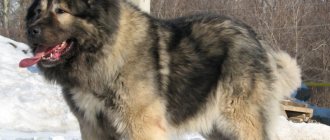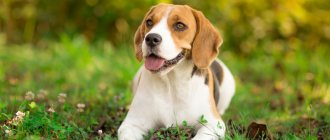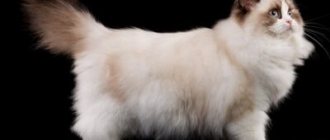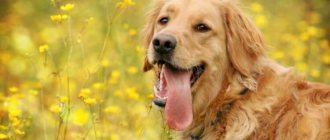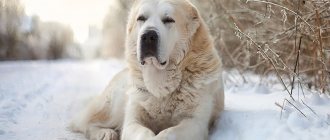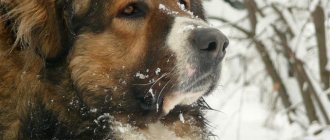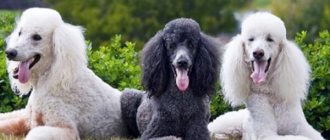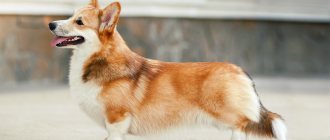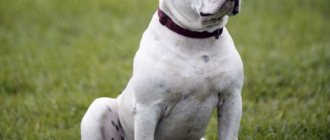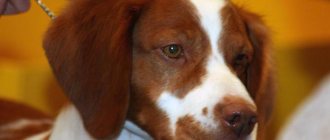Review author: “ZooVita”
These dogs are examples of strength, nobility, beauty and intelligence. Since ancient times, they were close to people, guarding their herds and homes, like true friends and helpers, but they did not turn into obedient servants. They are characterized by high intelligence, pride, self-sufficiency and endless loyalty to those who have tamed.
History of the origin of the breed
Chronicles compiled a thousand years BC mention fearless wolfhounds, which are probably the ancestors of the Caucasian Shepherd Dogs. It is known that the breed originated in East Asia, from where it came to the west of the continent, and then spread to Ancient Rome. During migration, a large population of animals remained in the mountainous areas of the North Caucasus, where they lived in isolation in a harsh climate, and underwent changes.
Large and strong dogs were bred to protect pastures from wolves and to hunt wild animals. In Urartu, shepherd dogs guarded fortresses and defended cities from enemy raids. On the coats of arms of the princes who ruled Georgia there is an image of a fearless Caucasian. In ancient China, a wolfhound puppy was given as a gift to the emperor. Russian breeders are proud of the watchdog. Local residents did not breed wolfhounds through selection; they were responsible for mating; shepherds selected the puppies, who developed endurance, agility and strength in the dogs.
Based on the breed, 4 populations independently formed:
- Dagestan;
- Georgian;
- Azerbaijani;
- Armenian
The steppe variety of wolfhound differs in appearance from animals that are bred in mountainous areas. Shepherd dogs belong to the same breed, although they are divided on territorial grounds. Guard dogs were brought to Russia during the Caucasian War, but breeders became interested in wolfhounds only after an exhibition held in Germany in the 30s of the 20th century. The selection of dogs and the restoration of the gene pool in the USSR began even later.
Breed characteristics and character
After the breed was recognized, it can be found not only in the Caucasus, but also outside the Russian Federation. She has taken a worthy place in the list of guard and security dogs. Males are larger than females, growing on average 75 centimeters and weighing up to 70-80 kilograms. The female individual is respectively 65 centimeters, weighing 55 kilograms. The height, appearance, weight of the Caucasian Shepherd depends on the geographical location:
1. Long hair, massive build, tall stature (Georgian look).
2. Medium height, long hair (Armenian).
3. Short hair, “dry” muscles, square-shaped body (Azerbaijani).
4. The largest in terms of mass and weight, the long-haired Dagestan species.
Despite the fact that the size of the Caucasian Shepherd is quite impressive, and the formidable appearance of the dog inspires fear, in fact it is a completely balanced, completely non-aggressive animal.
Caucasian Shepherd Dogs in the forest in autumn
Quickly becomes attached to its owner. They are distrustful of “strangers” and can become aggressive at the slightest threat. It is very important that the attention of the family where the pet lives, his willingness to defend them, has gained recognition and popularity among breeders.
Character traits:
- confidence;
- quick response at the moment of threat to the protected object;
- calmness in times of danger;
- persistence.
“Caucasian” is well adapted to weather conditions, so it can live outdoors and in apartment conditions. He learns quickly, thanks to his mental abilities and non-conflict nature. He treats children kindly and surrounds them with his patronage.
Description of the Caucasian Wolfhound breed with photo
The climatic conditions in which the population of aboriginal shepherds settled helped the animals adapt to low temperatures. Wolfhounds were forced to travel long distances, and became hardy and brave. Although the description of the breed appeared at the beginning of the 20th century, when the standard was approved by the canine association, it was possible to preserve Caucasian Shepherd Dogs with great difficulty, due to the death of most wolfhounds during the war. In order to restore the population in the USSR, nurseries were created and animals were presented at exhibitions. North Caucasian wolfhounds were identified as a separate breed only in 1990. The accepted standard applies not only to the character, size, type of coat, but also to the appearance of the dog:
| Structural features | Description |
| Body type | rough with strong bones |
| Head | large with a voluminous skull |
| Neck | with dewlap, muscular |
| Breast | elongated, lowered to the elbows |
| Back | straight |
| Small of the back | shortened, convex |
| Withers | developed |
| Paws | strong and large, located parallel |
| Tail | thick and fluffy |
The animal's voluminous muzzle tapers towards the nose, thick lips fit tightly to the skin. The oval eyes are dark brown. The small ears of the Caucasian wolfhound are set high.
Interesting! Wrinkles that stand out on the forehead give the dog an exotic appearance, emphasizing its fearless and independent appearance.
Breed standard
Dogs belong to large guard and security species. She has well-developed bones and muscle mass. The Caucasian Shepherd Kennel will provide you with a puppy that meets the approved parameters and advise you on how to care for it. Visual signs that are taken into account when purchasing:
Caucasian Shepherd dog on a walk in winter
1. The head has, from the top angle, the shape of an angle, greatly expanded towards the occipital region. The frontal bone is divided, defined by a groove. Deep muzzle, tapering towards the nose. The jaws are well developed with a straight bite. The tip of the nose is a deep black color.
2. The body of the animal is powerful, the withers protrude above the level of the sacrum. Paws are straight, parallel to each other. The area of the knee joints is clearly expressed. The tail is fluffy and pressed to the hind legs. The stomach is tucked.
3. The coat is coarse with a thick undercoat, shorter on the front of the paws and head than throughout the whole body.
The coat color is:
- pure white with spots of various colors;
- shades of piebald;
- brindle or fawn color;
- with reddish tan marks;
A distinctive feature of the “Caucasian” is the presence of a continuous rim around the lips and eyes. A dog can live, with proper care, 10 or 12 years. A litter of a cross between a Caucasian Shepherd and a German or Central Asian will be outbred, just like the offspring with an Alabai.
Young Caucasian Shepherd dog
Puppies may inherit the appearance of one or both parents. There will be no special differences in character traits from purebred “Caucasians”. If you are a cross with a mongrel or a husky, there is a high probability of getting offspring with an unstable psyche.
Color and coat type
The breed standard does not impose any color requirements on Caucasian wolfhounds. Red and white, black and fawn dogs take part in the exhibitions; spotted and striped pets are also found. Long-haired shepherd dogs with coarse hair about 10 cm long, lagging behind the body, and black lining on the lips and eyelids, are popular among dog handlers. Wolfhounds have tassels of fur on their ears, and cute “pants” cover their hips.
Smooth-haired representatives of the breed have a awn length of less than 50 mm and a short undercoat. The physique of these Caucasians resembles the Alabai.
Description of the Caucasian Shepherd
The breed was registered with the FCI in 1984. Standard No. 328 belongs to the 2nd group “Pinchers and Schnauzers, Molossians, Mountain and Swiss Cattle Dogs”, section 2.2 “Mountain Dogs”. When assessing a breed, no working tests are carried out.
Table: dog appearance standard
| Criterion | Description |
| Head | Large, massive, with a wide skull. The forehead is almost flat with a shallow groove. The transition from the forehead to the muzzle is noticeable, but not sharply pronounced. The nose is large and black. The muzzle is blunt, with a wide base, gradually tapering towards the nose. |
| Teeth | Scissor or level bite. Full dental formula (42 teeth). |
| Eyes | Medium size, oval, wide and deep set. The color is dark brown to hazelnut. The expression is serious and appreciative. |
| Ears | Small, thick, triangular in shape, set high and wide, hanging. Traditionally, they are docked short. |
| Neck | Powerful, with a pronounced scruff. |
| Tail | Set high, sickle or ring shaped. In a calm state it is lowered down, when excited it rises above the level of the back. |
| Limbs | Straight, parallel, with strong muscles. The paws are large, rounded, the toes are gathered into a ball. |
| Wool | Straight, hard, at least 5 cm long, with well-developed undercoat. It can form “tassels” on the ears, a “collar” on the neck, and “pants” on the hips. |
| Color | Any solid, piebald, spotted (a black mask on the face is desirable). |
| Height |
|
| Weight |
|
A black mask is desirable in Caucasian Shepherd colors
Disadvantages and reasons for disqualification of Caucasians
Any deviation from the requirements of the standard is considered a deficiency. Serious defects include:
- insecure behavior;
- the head is disproportionately small in relation to the body;
- sharp transition from forehead to muzzle;
- any deviation from the complete dental formula (except for the absence of first premolars);
- large, bulging, very light eyes, with a visible third eyelid, drooping eyelids;
- very large ears, thin or set too low;
- the coat is very soft, curly, very short, without undercoat;
- light bones, weak muscles and joint ligaments.
Disqualifying faults include:
- aggression or cowardice;
- any deviation from the correct bite;
- incomplete dental formula (absence of any tooth other than third molars (M3) or first premolars);
- eyesore, dark blue, green shades of eyes or eyes of different colors;
- docked tail;
- black color in any variations;
- genetic brown color in any combination;
- genetic brown pigmentation of the nose, lips and eyelids.
Character of the breed
Despite their enormous size, the appearance of Caucasian wolfhounds is very pleasant, reminiscent of a bear cub. But this soft plush appearance is deceptive; behind it lies a very serious dominant and stubborn character. “Caucasians” are focused on protecting and protecting people, and not on communicating with them. And although the pet will obey one owner and remain faithful to him until his last breath, the owner will not see concrete manifestations of love from him. This dog is one of those who proves everything with work. But here she has practically no equal. No one will be able to gain the trust of this watchman - he will remain indifferent to both delicacies and warm words, and it is also impossible to intimidate this giant.
Caucasian Shepherds are attentive and incorruptible guards
When surrounded by family, the look of these dogs becomes kinder. They are balanced and will not grumble or be capricious for any reason. Pets will be happy to watch children play, but will not allow themselves to be bullied. These are family protectors, not a stuffed toy for babies.
“Caucasians” will get along with other animals more easily the smaller their pets are. So, a wolfhound can compete with a large dog, but it can even make friends with a decorative “cutie”. Cats may also feel calm; the shepherd will consider it beneath his dignity to chase them.
Video: Caucasian Shepherd Dogs - features of the breed
Health and diseases of the Caucasian wolfhound
A breed that lived in harsh conditions has not only strength, but also good immunity, which protects the animal from many problems and prolongs life. However, due to their large size, dogs often gain excess weight and suffer from:
- clubfoot;
- hip dysplasia;
- subsidence of limbs.
Wolfhounds are affected by a viral infection. Vaccination is carried out to prevent leptospirosis, plague, hepatitis, tuberculosis, and rabies. The shepherd dog is inherited by diseases in which metabolism is disrupted and a tendency to allergies. Both 3 puppies and adult Caucasians are diagnosed with diabetes and epilepsy. It is not clear, but it is a fact that babies are sometimes born with severe albinism.
Keeping a Caucasian Shepherd Dog
The Caucasian Shepherd can be kept both in an apartment and in a private house, but it is worth considering a number of nuances:
- The dog is a giant breed, so it will be cramped in an average apartment.
- A shepherd dog requires physical activity most of the day, which is extremely difficult to provide at home. Excess energy can lead to destructive behavior in your pet.
- “Caucasians” shed very profusely, making it difficult to keep the house clean during these periods.
- Every stranger who crosses the threshold of the apartment is perceived by the shepherd as an aggressor, so the owner will have to carefully monitor its reaction.
The main fact in support of keeping a Caucasian Shepherd dog on the street is that these dogs are perfectly adapted to the harshest living conditions. The pet has enough shelter from strong winds and rain (most often this role is played by a spacious enclosure with a booth). The resting place should be located in such a way that the shaggy watchman can calmly inspect the territory entrusted to him. At the entrance to the dog-protected area there should be a sign notifying the presence of a shepherd dog (for example, “Beware, angry dog!”).
It is possible to put a guard on a chain, but this should be a short-term measure to, for example, allow guests into the house.
It’s good if a “Caucasian” has the opportunity to move freely around a protected area
Character
Owners of Pikines, Chihuahuas, and Yorkshire terriers consider wolfhounds to be vicious and aggressive dogs. If a Caucasian is raised correctly, the pet behaves calmly and becomes obedient, although the dog’s character is different:
- persistence;
- love of freedom;
- stubbornness;
- determination;
- dedication.
Reference! The Caucasian does not bark without reason, but is wary of strangers. The wolfhound is very attached to its owner, although it rarely shows emotions; staying at home, it finds something to do, but it is difficult for the dog to survive a long separation from the owner.
Intelligence and training
Caucasians are not pleased with their ability to learn. You have to work with a wolfhound and instill rules of behavior from the first days the puppy appears in the house. It is recommended to start training during long walks, since the baby must get used to people and animals. Despite the high intelligence of the pet, you should raise a wolfhound puppy as soon as he gets used to the new place and begins to respond to his name. The Caucasian Shepherd is easier to train:
- security,
- accompaniment;
- protection;
- transportation of goods;
- rescue service.
Wolfhound training, which is best entrusted to a dog handler, begins at 3 months. At the first stage of training, a relationship is established between the owner and the puppy. After the dog has mastered simple techniques, they move on to complex ones. It is recommended to conduct classes not immediately after feeding, but after a couple of hours.
Breed traits
Breed traits (on a 5-point scale)
| Caucasian Shepherd Dog | |||
| Activity | in the house | 3 | |
| on the street | 4 | ||
| Obedience | training | 1.9 | |
| strangers | 1 | ||
| Domination | in family | 2.9 | |
| over dogs | 3.4 | ||
| Defending your territory | from people | 3.8 | |
| from dogs | 3.9 | ||
| Sociability | in family | 3.5 | |
| with strangers | 1.2 | ||
| with dogs | 1.5 | ||
| Concentration | in family | 3 | |
| in front of strangers | 2 | ||
| with dogs | 2 | ||
| Aggressiveness | in family | 2 | |
| to strangers | 5 | ||
| to the dogs | 4.5 | ||
| to cats | 2.8 | ||
| Family behavior | calmness | 2 | |
| demand for affection | 2 | ||
| excitability | 3.1 | ||
| playfulness | 1.9 | ||
| excessive barking | 2 | ||
| behavioral breakdowns | 2.6 | ||
| Tolerance for children | up to 4 years | 1.5 | |
| over 4 years old | 1.6 | ||
| Institutional use | watchman | 4.8 | |
| bodyguard | 4.9 | ||
This breed is often compared to the following dog breeds: German Shepherd, Saint Bernard, Leonberger, Rottweiler, Newfoundland.
The Caucasian Shepherd is considered aggressive and angry, but with proper training it is a loyal, affectionate and obedient pet. Although it is difficult to cope with this independent and stubborn animal. Therefore, before getting a dog of this breed, you need to study its characteristics, the pros and cons of keeping it, and reviews from the owners.
The photographs show what a Caucasian Shepherd looks like:
Pros and cons of the breed
A wolfhound, which is raised by its owner from an early age, becomes an excellent watchman and protector. The presence of guard qualities distinguishes the Caucasian from other breeds. A dog with a decisive character and high intelligence is able to independently sense when the owner is in danger and choose a strategy, even when there is no command from a person.
The disadvantages of the breed are:
- suspicion and distrust of others;
- training difficulties:
- demanding care and maintenance.
Attention! The dog listens only to a strong owner and needs early socialization. If raised incorrectly, the pet turns into an angry and aggressive dog.
Maintenance and care
You need to constantly care for your wolfhound. To ensure that the coat looks neat and does not roll into tangles, the dog is combed every three days with a brush or metal comb, and during shedding - daily. After bathing with a moisturizing shampoo, the wolfhound’s hair is rinsed with a solution made from vinegar or citric acid.
The dog's ears are cropped no later than 2 days after birth. At the end of the walk, the sinks are wiped with a swab, which is moistened in boric alcohol. Chamomile decoction is used to wash sore eyes. Once a week, your pet's teeth are examined and cleaned.
After a walk, it is recommended to wipe the dog’s paws with a wet rag; if cracks form on the pads, lubricate them with any vegetable oil. To prevent fleas from appearing on the wolfhound, an anti-parasite preparation is applied to the dog’s withers every 20 or 25 days.
Reference! The Caucasian Shepherd feels comfortable in a spacious enclosure in the courtyard of a private house.
Keeping at home
In the apartment, the dog is given a separate, permanent place, to which the animal will be accustomed from childhood. Considering that the coat is thick, the lounger is placed away from heating radiators. Care must be taken to ensure there is sufficient light and no drafts.
The resting place should be organized taking into account the size of the animal. Mandatory presence of fabric bedding. It is cleaned and treated with disinfectants (approved for use) once every two months. Possibly more often as it gets dirty.
Caucasian Shepherd puppies in the meadow in summer
The dog's permanent place should not be near the kitchen or dining room. Near the refrigerator and in a walk-through area. The shepherd dog kept in the apartment is walked in the morning and evening.
How to choose a wolfhound puppy
Before buying a baby, it is advised to pay attention to the appearance, look at the condition of the eyes, nose, and check the bite.
You can tell whether a wolfhound puppy has a stable psyche by its behavior. A healthy dog is active and lively:
- Playing with his brothers.
- Pushes his sisters.
- Shows teeth.
- Tries to bite a stranger.
The seller is obliged to present the Caucasian buyer with a veterinary passport, vaccination paper, and pedigree information. Although the cost of a purebred puppy in a nursery reaches 50 thousand rubles, it is not recommended to save money by purchasing a baby from a private person.
Having fallen in love with the owner, the brave dog is devoted to him limitlessly; in case of a threat, he is capable of sacrificing his life to protect both the owner and his family.
